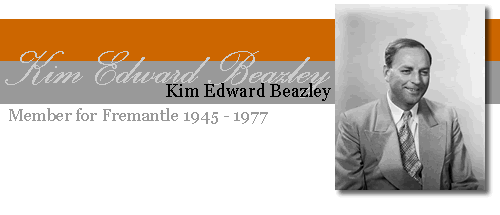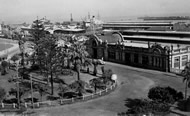
Kim Edward Beazley was born in Northam, Western Australia on 30 September 1917, son of Alfred, a storeman and packer, and his wife Mary Wright. After attending government schools in the Fremantle area Kim went to Perth Modern School in 1933, studying subsequently at Claremont Teachers' College, the University of Western Australia and then the Australian National University from where he obtained a Master of Arts soon after his entry into Parliament.
In 1937 he commenced work with the Education Department and taught successively at Richmond (East Fremantle), Arthur River (near Wagin), Midland Junction and Claremont. At the time of his nomination for the Fremantle seat in 1945 he was living in Claremont, tutoring at Claremont Teachers' Training College and lecturing for the Adult Education Board (to which he had been seconded in 1944 to tour the countryside organising discussions). He had also tutored at the University of Western Australia and became vice president of the State School Teachers' Union and a member of the Australian Teachers' Federation.
Beazley had first joined the ALP through the Labor Club at UWA and became a delegate to the Metropolitan Council and member of the State Executive. In later years (1969-1971) he was the party's senior vice president.
Following Curtin's death Beazley was Labor's endorsed candidate for the Fremantle seat and on 18 August 1945, in a field of six candidates, he won the seat with an absolute majority of nearly 9000 votes: a year later he defeated his Liberal opponent in the 1946 general election by almost 20,000 votes. His majority was reduced to 3870 in the 1949 general election but this then remained easily his smallest winning margin until the 1975 landslide when his share of the vote in a straight out contest with a Liberal opponent fell to below 52% and a majority of just over 2,000.
A practising Christian, Beazley embraced the Moral Rearmament Movement2 in 1953. In 1954-55 came the split in the ALP and the formation of the Democratic Labor Party, a development Beazley regretted. He continued to adhere to the ALP and was on the party's parliamentary executive from 1963. When Labor returned to power under Whitlam in 1972, Beazley held the Education portfolio throughout the government's three year span. From 1967 to 1969 he had served on the Joint Committee on Foreign Affairs of which he was vice chairman in 1968 and between 1949 and 1972 he was a member of the Council of the Australian National University. From 1964 to 1972 Beazley served on the Council of the Australian Institute of Aboriginal Studies.
In his retirement years he headed a major ground-breaking inquiry into Western Australia's Education system and during the term of the Dowding Government he chaired a joint parliamentary-lay committee which investigated aspects of parliamentary privilege . Married to Betty Judge at Christ Church Claremont on 7 February 1948 Beazley had two sons, including Rhodes Scholar and Federal Parliamentary Labor Party leader Kim Christian Beazley, and one daughter.
The youngest member (aged 27) of the Federal Parliament at the time of his first election victory in 1945, Beazley was the last surviving pre-1949 Federal politician when he died at Claremont on 12 October 2007.
s.jpg)
s.jpg)
s.jpg)
